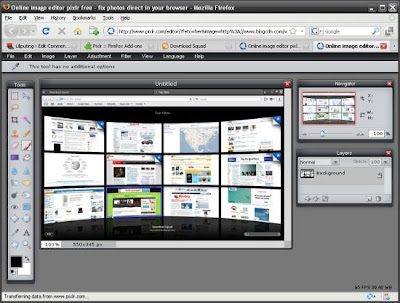Why Pixlr is Best Image Editing Site ?
 Online image editing has really taken off recently, making this a difficult category to judge because of the number of exemplary image editing web applications available.
Online image editing has really taken off recently, making this a difficult category to judge because of the number of exemplary image editing web applications available.There are a few web sites that allow basic image editing: these include Fotoflexer, Lunapic, Picnic and Adobe Photoshop’s online version, the disappointingly very basic, Photoshop Express. You can add layers and text to the photos, as well as choose from a large number of preset shapes, frames and objects. Fotoflexer and Lunapic also allow users to add animated overlays to their images.
Then, there is another class of image editor which allows much more control and a range of drawing and image editing tools. The shortlist consisted of Pixlr, Aviary Phoenix, Splashup and Sumo Paint. These are all web applications with a lot of functionality, including multi-layer support, filters, image-adjustment and in some cases, even plugins. All these image editors run on the Flash platform.
All the short-listed sites have the same basic layout. Along the right, the tools are located. Along the top edge of the screen is the menu bar. Below the menu bar is a parameter bar for tweaking various aspects of the tools being used at any point in time. All these sites are designed following the layout of Adobe Photoshop, so those who have used Photoshop should have a very short learning curve on any of these image editors.
All of them let you start editing images right away. Creating a new image quickly, or opening an image from your hard drive is just a few clicks away. Aviary Phoenix, Sumo Paint and Splashup all allow you to sign up for an account, and create an online space where you can save and share your creations. Pixlr does not have this option, and you cannot sign up even if you want to. Pixlr let’s you save images only on your hard drive.
When it comes to opening images though, each image editing tool has its own set of unique advantages. Sumopaint can open only the basic JPG, PNG and GIF images, and open from a hotlink on the web. Splashup can open JPG, BMP, TIF and PNG, but has an amazing open dialogue box that interfaces with Picasa, Facebook, Flickr, Smugmug and Photobucket. You can retrieve any image you have hosted on any of these sites using Splashup, or use a link to an image. Pixlr is a little strange as it does not load BMP files, but has support for PSD files. Make sure you save the Photoshop .psd file with the “Maximum Compatibility” option checked, though.
Aviary Phoenix has a misleading window that let’s you open up any kind of file on your machine, but choosing heavy files tends to hang the browser you are using. Aviary also supports PSD files. Aviary Phoenix also lets you import files from Flickr, Picasa and Facebook.
Both Pixlr and Splashup allow you to move the layer, history and associated windows around the workspace. Splashup also allows you to resize the windows horizontally, but not vertically. Sumopaint uses a drop-down approach, where windows can be shown or hidden at the click of a button – this is a convenient and easy approach. Aviary Phoenix has a very static window, which you can neither move nor resize. When it comes to selecting brushes, Splashup has the smallest number of brushes, as well as the smallest number of customization options. Pixlr has an impressive brush editor that let’s you tweak and change various aspects of the brushes. Aviary has a fair few options, better than Splashup, but not as good as Pixlr. Sumopaint, however, stands out here with a very comprehensive brush editor, a large number of presets, and a large number of brushes, too. Sumopaint really stands out when it comes to the tools. Splashup has 20 tools, Pixlr has 25, Aviary Phoenix, 27, and Sumopaint has 32. A really innovative control option for some of the tools on Sumopaint is the ability to move the cursor around the focus point when drawing a shape. This changes the shape in a number of ways, and lets you draw a wide range of stars and polygons after selecting a single tool. There is also a symmetrical paint option that lets you paint on the image using a number of paintbrushes that move in an identical manner with respect to the edge of the image from which the cursor is moved.
We used each image editor in an actual design scenario, and pushed them all till they broke. Aviary Phoenix does not let you open two files at once, so gets out of the running right there. Sumopaint buckles because of the selection options being rather buggy, and the shortcut keys not working properly. Splashup struggles when large files are loaded, and suffers from a very limited zooming mechanism. Pixlr allows you to zoom in and out intuitively, with a slider option to aid you. Opening a number of large images is a breeze, and many Photoshop shortcut keys work. Some bugs appear after extensive work (over an hour), but Pixlr is the only service that let’s you meaningfully get till there. You can always save files in a Pixlr format (PXD) that retains the layers. If you want to get some serious photo editing done online, Pixlr is the service that truly delivers and so gets our web award.



 TechQuark is a mobile-friendly website. Simply bookmark
TechQuark is a mobile-friendly website. Simply bookmark 